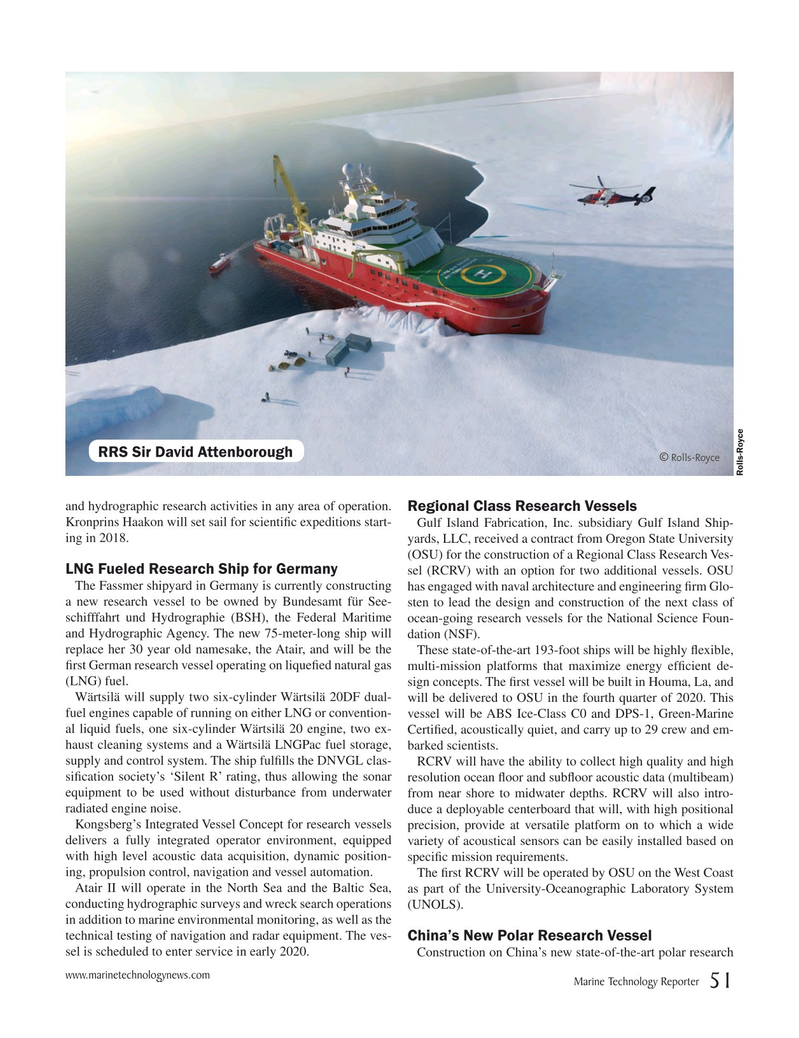
Page 51: of Marine Technology Magazine (September 2017)
Ocean Observation: Gliders, Buoys & Sub-Surface Networks
Read this page in Pdf, Flash or Html5 edition of September 2017 Marine Technology Magazine
RRS Sir David Attenborough
Rolls-Royce and hydrographic research activities in any area of operation.
Regional Class Research Vessels
Kronprins Haakon will set sail for scienti? c expeditions start- Gulf Island Fabrication, Inc. subsidiary Gulf Island Ship- ing in 2018. yards, LLC, received a contract from Oregon State University (OSU) for the construction of a Regional Class Research Ves-
LNG Fueled Research Ship for Germany sel (RCRV) with an option for two additional vessels. OSU
The Fassmer shipyard in Germany is currently constructing has engaged with naval architecture and engineering ? rm Glo- a new research vessel to be owned by Bundesamt für See- sten to lead the design and construction of the next class of schifffahrt und Hydrographie (BSH), the Federal Maritime ocean-going research vessels for the National Science Foun- and Hydrographic Agency. The new 75-meter-long ship will dation (NSF).
replace her 30 year old namesake, the Atair, and will be the These state-of-the-art 193-foot ships will be highly ? exible, ? rst German research vessel operating on lique? ed natural gas multi-mission platforms that maximize energy ef? cient de- (LNG) fuel. sign concepts. The ? rst vessel will be built in Houma, La, and
Wärtsilä will supply two six-cylinder Wärtsilä 20DF dual- will be delivered to OSU in the fourth quarter of 2020. This fuel engines capable of running on either LNG or convention- vessel will be ABS Ice-Class C0 and DPS-1, Green-Marine al liquid fuels, one six-cylinder Wärtsilä 20 engine, two ex- Certi? ed, acoustically quiet, and carry up to 29 crew and em- haust cleaning systems and a Wärtsilä LNGPac fuel storage, barked scientists.
supply and control system. The ship ful? lls the DNVGL clas- RCRV will have the ability to collect high quality and high si? cation society’s ‘Silent R’ rating, thus allowing the sonar resolution ocean ? oor and sub? oor acoustic data (multibeam) equipment to be used without disturbance from underwater from near shore to midwater depths. RCRV will also intro- radiated engine noise. duce a deployable centerboard that will, with high positional
Kongsberg’s Integrated Vessel Concept for research vessels precision, provide at versatile platform on to which a wide delivers a fully integrated operator environment, equipped variety of acoustical sensors can be easily installed based on with high level acoustic data acquisition, dynamic position- speci? c mission requirements.
ing, propulsion control, navigation and vessel automation. The ? rst RCRV will be operated by OSU on the West Coast
Atair II will operate in the North Sea and the Baltic Sea, as part of the University-Oceanographic Laboratory System conducting hydrographic surveys and wreck search operations (UNOLS).
in addition to marine environmental monitoring, as well as the technical testing of navigation and radar equipment. The ves-
China’s New Polar Research Vessel sel is scheduled to enter service in early 2020. Construction on China’s new state-of-the-art polar research www.marinetechnologynews.com
Marine Technology Reporter 51
MTR #7 (50-63).indd 51 MTR #7 (50-63).indd 51 8/23/2017 4:34:32 PM8/23/2017 4:34:32 PM

 50
50

 52
52
